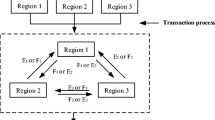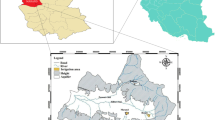Abstract
Water resources are fundamental for support of regional development. Effective planning can facilitate sustainable management of water resources to balance socioeconomic development and water conservation. In this research, coupled planning of water resources and agricultural land use was undertaken through the development of an inexact-stochastic programming approach. Such an inexact modeling approach was the integration of interval linear programming and chance-constraint programming methods. It was employed to successfully tackle uncertainty in the form of interval numbers and probabilistic distributions existing in water resource systems. Then it was applied to a typical regional water resource system for demonstrating its applicability and validity through generating efficient system solutions. Based on the process of modeling formulation and result analysis, the developed model could be used for helping identify optimal water resource utilization patterns and the corresponding agricultural land-use schemes in three sub-regions. Furthermore, a number of decision alternatives were generated under multiple water-supply conditions, which could help decision makers identify desired management policies.
Similar content being viewed by others
References
Abu-Taleb M, Mareschal B (1995). Water resources planning in the Middle East: application of the PROMETHEE V multicriteria method. Eur J Oper Res, 81(3): 500–511
Bao C, Fang C L (2007). Water resources constraint force on urbanization in water deficient regions: case study of the Hexi Corridor, arid area of NW China. Ecol Econ, 62(3–4): 508–517
Bender M J, Simonovic S P (2000). A fuzzy compromise approach to water resource systems planning under uncertainty. Fuzzy Sets Syst, 115(1): 35–44
Cai Y P, Huang G H, Nie X H, Li Y P, Tan Q (2007). Municipal solid waste management under uncertainty: a mixed interval parameter fuzzy-stochastic robust programming approach. Environ Eng Sci, 24(3): 338–352
Cai Y P, Huang G H, Tan Q (2009c). An inexact optimization model for regional energy systems planning in the mixed stochastic and fuzzy environment. Int J Energy Res, 33(5): 443–468
Cai Y P, Huang G H, Tan Q, Yang Z F (2009a). Planning of community-scale renewable energy management systems in a mixed stochastic and fuzzy environment. Renew Energy, 34(7): 1833–1847
Cai Y P, Huang G H, Yang Z F, Lin Q G, Tan Q (2009b). Community-scale renewable energy systems planning under uncertainty-an interval chance-constrained programming approach. Renew Sustain Energy Rev, 13(4): 721–735
Carter N, Kreutzwiser R D, de Loë R C (2005). Closing the circle: linking land use planning and water management. Land Use Policy, 22(2): 115–127
Castelletti A, Pianosi F, Soncini-Sessa R (2008). Integration, participation and optimal control in water resources planning and management. Appl Math Comput, 206(1): 21–33
Chen Y, Marc Kilgour D, Hipel K W (2006). Multiple criteria classification with an application in water resources planning. Comput Oper Res, 33(11): 3301–3323
Dong C, Huang G H, Cai Y P, Liu Y (2012). An inexact optimization modeling approach for supporting energy systems planning and air pollution mitigation in Beijing city. Energy, 37(1): 673–688
Fagan J E, Reuter M A, Langford K J (2010). Dynamic performance metrics to assess sustainability and cost effectiveness of integrated urban water systems. Resour Conserv Recycling, 54(10): 719–736
Huang G H (1996). IPWM: an interval parameter water quality management model. Eng Optim, 26(2): 79–103
Huang G H, Batez B W, Patry G G (1992). A grey linear programming approach for municipal solid waste management planning under uncertainty. Civ Eng Syst, 9(4): 319–335
Huang G H, Batez B W, Patry G G (1995a). Grey quadratic programming and its application to municipal solid waste management planning under uncertainty. Eng Optim, 23(3): 201–223
Huang G H, Batez B W, Patry G G (1995b). Grey integer programming: an application to waste management planning under uncertainty. Eur J Oper Res, 83(3): 594–620
Jiang Y, Liu J, Cui Q, An X H, Wu C X (2011). Land use/land cover change and driving force analysis in Xishuangbanna Region in 1986–2008. Frontiers of Earth Science, 5(3): 288–293
Karmakar S, Mujumdar P P (2006). An inexact optimization approach for river water-quality management. J Environ Manage, 81(3): 233–248
Li W, Li Y P, Li C H, Huang G H (2010). An inexact two-stage water management model for planning agricultural irrigation under uncertainty. Agric Water Manage, 97(11): 1905–1914
Loukas A, Mylopoulos N, Vasiliades L (2007). A modeling system for the evaluation of water resources management strategies in Thessaly, Greece. Water Resour Manage, 21(10): 1673–1702
Lu H W, Huang G H, Zhang Y M, He L (2012). Strategic agricultural land-use planning in response to water-supplier variation in a China’s rural region. Agric Syst, 108: 19–28
Mahmoud M I, Gupta H V, Rajagopal S (2011). Scenario development for water resources planning and watershed management: methodology and semi-arid region case study. Environ Model Softw, 26(7): 873–885
Mainuddin M, Das Gupta A, Rai Onta P (1997). Optimal crop planning model for an existing groundwater irrigation project in Thailand. Agric Water Manage, 33(1): 43–62
Mugabi J, Kayaga S, Njiru C (2007). Strategic planning for water utilities in developing countries. Util Policy, 15(1): 1–8
Pang A P, Li C H, Sun T, Yang Z F (2013). An improved ET control method to determine the water-saving potential for farmland in Baiyangdian Watershed, China. Frontiers of Earth Science, 7(2): 151–158
Patterson C L, Adams J Q (2011). Emergency response planning to reduce the impact of contaminated drinking water during natural disasters. Frontiers of Earth Science, 5(4): 341–349
Qin X S, Huang G H, Chakma A (2008). Modeling groundwater contamination under uncertainty: a factorial-design-based stochastic approach. Journal of Environmental Informatics, 11(1): 11–20
Reca J, Roldan J, Alcaide M, Lopez R, Camacho E (2001). Optimization model for water allocation in deficit irrigation systems: I. Description of the model. Agric Water Manage, 48(2): 103–116
Seifi A, Hipel K W (2001). Interior-point method for reservoir operation with stochastic inflows. J Water Resour Plan Manage, 127(1): 48–57
Sethi L N, Panda S N, Nayak M K (2006). Optimal crop planning and water resources allocation in a coastal groundwater basin, Orissa, India. Agric Water Manage, 83(3): 209–220
Sutardi, Bettorb C R, Goulter I (1995). Multiobjective water resources investment planning under budgetary uncertainty and fuzzy environment. European Journal of Operational Research, 82(3): 556–591
Tan Q, Huang G H, Cai Y P (2010). Identification of optimal plans for municipal solid waste management in an environment of fuzziness and two-layer randomness. Stochastic Environ Res Risk Assess, 24(1): 147–164
Tan Q, Huang G H, Cai Y P (2011). Radial interval chance-constrained programming for agricultural non-point source water pollution control under uncertainty. Agric Water Manage, 98(10): 1595–1606
Weng S Q, Huang G H, Li Y P (2010). An integrated scenario-based multi-criteria decision support system for water resources management and planning-a case study in the Haihe River Basin. Expert Syst Appl, 37(12): 8242–8254
Younos T (2011). Paradigm shift: holistic approach for water management in urban environments. Frontiers of Earth Science, 5(4): 421–427
Zhang X H, Zhang H W, Chen B, Chen G Q, Zhao X H (2008). Water resources planning based on complex system dynamics: a case study of Tianjin city. Commun Nonlinear Sci Numer Simul, 13(10): 2328–2336
Author information
Authors and Affiliations
Corresponding author
Rights and permissions
About this article
Cite this article
Dong, C., Huang, G., Tan, Q. et al. Coupled planning of water resources and agricultural landuse based on an inexact-stochastic programming model. Front. Earth Sci. 8, 70–80 (2014). https://doi.org/10.1007/s11707-013-0388-5
Received:
Accepted:
Published:
Issue Date:
DOI: https://doi.org/10.1007/s11707-013-0388-5




